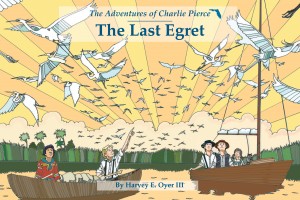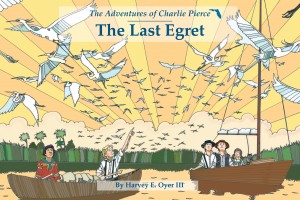 Author digs into his own past for kids' book
Author digs into his own past for kids' book
Harvey Oyer finds self-publishing best way to get his story out there.
October 17, 2010|By Chauncey Mabe, Sun Sentinel Correspondent
Harvey Oyer is the first to admit that patience is not one of his virtues. So when he got the idea of writing a series of children's books on Palm Beach County history and ecology, he went straight for the do-it-yourself route.
"I looked at the process of pitching a book to the New York publishers, and I wasn't interested in the brain damage," Oyer says. "Hundreds of letters back and forth, they change your story, it takes a year to publish. No thanks."


Oyer's first book, "The Adventures of Charlie Pierce: The American Jungle," surpassed his hopes. Based on the childhood of his great-grand uncle, a Florida pioneer, it sold 7,000 copies and last weekend at the Florida Publishing Association's awards banquet in Sarasota, it won gold medals in the children's fiction category and the Florida children's book division.
Now the second book in the series, "The Adventures of Charlie Pierce: The Last Egret," has been chosen by Palm Beach County schools to be read by the district's 14,000 fourth-graders.
Oyer might turn out to be a pioneer himself — pointing the way for the future of publishing.
"Who needs the nonsense of publishing companies when you can produce and distribute books yourself?" Oyer asks. "I believe the future of both book and music distribution is the Internet and social media rather than traditional publishing or stores."
Before you fire up Google in search of self-publishing options, be warned that Oyer's results, as they say in the weight-loss ads, may not be typical. That's because there's nothing typical about the author.
Not only is Oyer a well-connected Palm Beach County real-estate lawyer, he's also an amateur scientist with an archaeology degree from Oxford University. He's a member of the fabled Explorers Club, which has sent him on expeditions to Papua New Guinea and Grand Bahama.
In the Grand Bahama trip, Oyer served as marine archaelogist on a reconnaisance of the reef, but his participation in Papua New Guinea, on an Explorers Club flag expedition, was more significant.
Along with 40 others, Oyer pressed deep into the jungle in seach of remote villages to record the myths and histories of Papuan people — many had never seen white people — before they were obscured by encroaching civilization.
Oyer's report, "Christian Missionizing and the Destruction of Cultural Heritage in the Highands of Papua New Guinea," appeared in The Explorers Journal, fall 2008.
"The Explorers Club is the neatest group of people imaginable," Oyer says. "It started as a purely explorers' organization but shifted to science and adventure as the world was explored. Now it's more about preserving the world."
Indeed, Oyer is an ardent preservationist, a past chairman of the Historical Society of the Palm Beaches who campaigned tirelessly to save the 1916 courthouse. He keeps up a strenuous speaking schedule.

"I've spoken in 150-200 schools," Oyer says. "I know what appeals to kids, what makes the hands go up, what excites and entertains. I became concerned we weren't teaching history and conservation in a way that interested kids. That's why I wrote the books."
Oyer didn't have to look far to find a subject for the kind of book he had in mind. A fifth-generation descendent of Florida pioneers, he grew up hearing tales about Charlie Pierce, who in 1872, at age 8, came to Jupiter, where his father was assistant lighthouse keeper.
The family moved to Hypoluxo Island a year later, where Charlie's sister, Lillie, was born in 1876 — the first white child born between Jupiter and Miami, a region that now holds 7 million people.
Charlie grew up to be one of the fabled "barefoot mailmen," walking the beach from Palm Beach to Miami.
"My family arrived at an almost unexplored world," Oyer says. "Their only neighbors for 50 miles in either direction were Seminole Indians. My family witnessed the entire development and evolution of modern Florida."
Oyer hasn't written about Charlie Pierce as the barefoot mailman, since the books focus on his childhood. The first one is the story of his early days on Hypoluxo Island and his friendship with a Seminole boy named Tiger Bowlegs.
"I took the real-life stories of my own family and I couldn't have dreamt up better ones," Oyer says. "Charlie kept a journal from the age of 8 until his death in 1939, plus years of family oral history. And I backstopped that with my own research."
By going it alone, without the help of a traditional publisher, Oyer had no support with promotion or distribution. But he doesn't lack energy — by the time he approached Palm Beach County with "The Last Egret," he already had sponsors lined up.
That includes the Arthur Marshall Foundation and the Historical Society of the Palm Beaches, which will sponsor field trips for the fourth-graders to the Everglades and the Johnson Museum, respectively.
Then there's Wachovia/Wells Fargo, which donated the entire $87,000 publishing cost to give the book to 14,000 fourth-graders.
A cautionary environmental tale in which Charlie gets involved with the plume hunters who decimated Florida's bird population in the late 19th century, "The Last Egret" obviously has wide appeal.
Liz Perlman, Palm Beach County schools district director for elementary curriculum, says she's "happy anytime someone wants to donate books," adding she'd be "thrilled" if other corporate donors stepped up for every grade level.


But that wasn't enough. "The Last Egret" still had to go through a thorough review by the school system's literacy team to make sure the book was up to standards and appropriate for lesson development.
"It's very well-written," Perlman says, "and the timing was great. We study Florida in fourth grade, and this is the year of the Everglades. To use this book to talk about Florida history and ecology is awesome."
No matter how much Oyer is committed to self-publishing, he knows the importance of professional editorial quality control. He turned to Middle River Press, a boutique "custom publishing" company in Fort Lauderdale to produce his books.
"Middle River Press had a very good editor who helped me greatly with the tone and building characters," Oyer says. "You have to understand what they are good at: layout, graphic design, editing. They did a wonderful job."
Judy Borich, a former newspaper photographer who started Middle River Press six years ago with husband Bruce, also a photographer, says Oyer is the epitome of "the successful custom author."
"His books are successful not only because they are great books, but because he's out there letting people know about them," Borich says.
Borich won't go so far as to predict self-publishing as the future of the book industry, but she's sure it will be "a part of it."
Increasingly, established writers are self-publishing. Literary novelist John Edgar Wideman self-published his latest book, "Briefs," in March. Edgar-winning crime novelist Jonathan King hired Middle River Press for his latest mystery, "Styx."
"Custom publishing is really taking off," Borich says. "I like to think it's getting bigger and bigger. A lot of self-publishing makes it too easy. Just upload your book, with no editing, no proofreading. If you want a quality professional book you'll look for someone like Middle River Press."
Meanwhile, Oyer continues to gain traction with his books. Zac and Judd Cherry, brothers who grew up in Palm Beach, are working to put together financing and turn "American Jungle" into a movie. Judd Cherry is a Hollywood screenwriter whose credits include "Night at the Museum."

"I hope it works out, but I'm not holding my breath," Oyer says. "It would make a terrific movie. A lot of stories get optioned, though. But it's the right group. They're from here, they have the showbiz credits."
Full Article link










